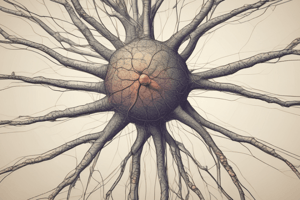Podcast
Questions and Answers
Which part of the nervous system includes everything outside of the brain and spinal cord?
Which part of the nervous system includes everything outside of the brain and spinal cord?
- Motor pathways
- Central nervous system
- Sensory pathways
- Peripheral nervous system (correct)
Sensory neurons carry information away from the central nervous system.
Sensory neurons carry information away from the central nervous system.
False (B)
What neurotransmitter is used at the neuromuscular junction?
What neurotransmitter is used at the neuromuscular junction?
Acetylcholine
The propagation of information along an axon is known as ______.
The propagation of information along an axon is known as ______.
Match the following terms with their descriptions:
Match the following terms with their descriptions:
What is the main function of the myelin sheath in a neuron?
What is the main function of the myelin sheath in a neuron?
Electrical signals move slower than chemical signals in neuronal communication.
Electrical signals move slower than chemical signals in neuronal communication.
What type of ion channel opens in response to a change in membrane potential?
What type of ion channel opens in response to a change in membrane potential?
The zone of the neuron where the action potential is first generated due to voltage-gated ion channels is the ______.
The zone of the neuron where the action potential is first generated due to voltage-gated ion channels is the ______.
Match the following cell types with their descriptions:
Match the following cell types with their descriptions:
Flashcards
Central Nervous System
Central Nervous System
The part of the nervous system that consists of the brain and spinal cord.
Peripheral Nervous System
Peripheral Nervous System
The nervous system outside the central nervous system, encompassing all other neural elements.
Motor Neuron
Motor Neuron
A neuron that sends impulses from the central nervous system to muscles or glands.
Sensory Neuron
Sensory Neuron
Signup and view all the flashcards
Axon
Axon
Signup and view all the flashcards
Neurotransmitter
Neurotransmitter
Signup and view all the flashcards
Depolarization
Depolarization
Signup and view all the flashcards
Graded Potentials
Graded Potentials
Signup and view all the flashcards
Action Potential
Action Potential
Signup and view all the flashcards
Synaptic Cleft
Synaptic Cleft
Signup and view all the flashcards
Study Notes
Nervous Tissue Overview
- Nervous tissue is categorized into central and peripheral components
- Central nervous system: brain and spinal cord
- Peripheral nervous system: all other nerve tissue
Neuron Structure
- Neuron structure consists of a cell body (soma), dendrites, and an axon.
- Dendrites receive signals from other neurons.
- The axon transmits signals away from the cell body.
- Axon hillock: where the axon originates
- These communicate between neurons via synapses
- Axon terminals: branches at the end of the axon
Neuron Types
- Sensory neurons: carry sensory information to the central nervous system, generally unipolar.
- Interneurons: connect sensory and motor neurons within the central nervous system, generally multipolar.
- Motor neurons: carry signals from the central nervous system to muscles or glands; generally multipolar.
Neuron Function
- Neurons communicate through nerve impulses (action potentials).
- Nerve impulses travel along the axon to the axon terminals.
- Communication between neurons occurs via chemical or electrical synapses.
Synapses
- Synapses are junctions between neurons that allow communication.
- Chemical synapses use neurotransmitters to transmit signals.
- Electrical synapses use gap junctions for direct transmission.
Myelination
- Myelin sheaths insulate axons, speeding nerve impulse transmission.
- Schwann cells form myelin sheaths in the peripheral nervous system.
- Oligodendrocytes form myelin sheaths in the central nervous system.
Synaptic Transmission
- Action potential reaches the axon terminal of a presynaptic neuron
- Voltage-gated Calcium channels open and calcium enters axon terminal
- Triggers fusion of synaptic vesicles with the plasma membrane and neurotransmitter release into synaptic cleft
- Neurotransmitter diffuses across synaptic cleft and attaches to receptors on post-synaptic cell or muscle cell
- Post-synaptic cell or muscle cell depolarizes which may trigger propagation of an action potential
- Neurotransmitter removal from the synaptic cleft required to terminate the signal.
Action Potentials
-
Electrical signals, transmitted along the axon.
-
Depolarization: the membrane potential becomes less negative.
-
Repolarization: the membrane potential returns to a resting state.
-
Voltage-gated channels open and close to regulate the flow of ions.
-
Refractory periods: time after an action potential when the neuron cannot fire another action potential.
-
Absolute refractory period: no action potential possible.
-
Relative refractory period: more difficult to elicit an action potential
Postsynaptic Potentials (graded potentials)
- Excitatory postsynaptic potential (EPSP): brings membrane potential closer to threshold
- Inhibitory postsynaptic potential (IPSP): brings membrane potential further from threshold
- Synaptic potentials integrate to determine whether an action potential occurs.
Temporal and Spatial Summation
- Temporal summation: multiple signals arriving rapidly at a neuron add together
- Spatial summation: signals arriving at different locations on the neuron add together.
Neuromuscular Junction
- The synapse between a motor neuron and a muscle fiber.
- Acetylcholine (ACh) is the neurotransmitter.
Skeletal Muscle Excitation/Contraction Coupling
- The process by which a nerve impulse leads to muscle contraction
- Action potential travels along the axon to stimulate the release of Acetylcholine at the neuromuscular junction.
- Binding of ACh to its receptors opens ion channels which creates an action potential in muscle cell membrane
- Propagation of this action potential along muscle cell membrane
- Leads to release of calcium ions (Ca2+) from sarcoplasmic reticulum
- The calcium ions trigger muscle contraction
- Calcium removal leads to muscle relaxation
Studying That Suits You
Use AI to generate personalized quizzes and flashcards to suit your learning preferences.




